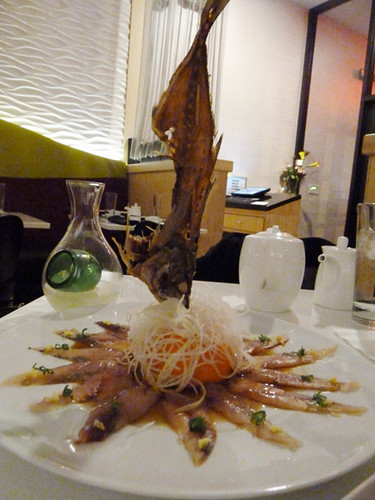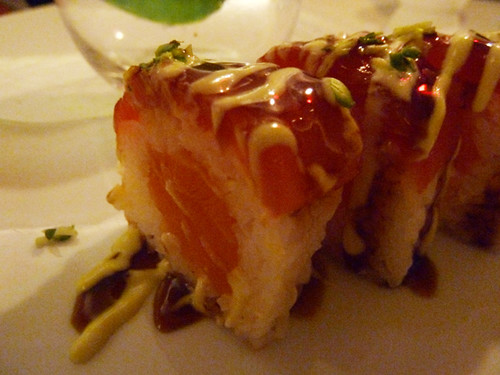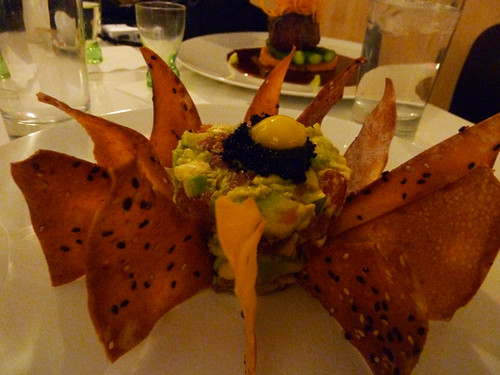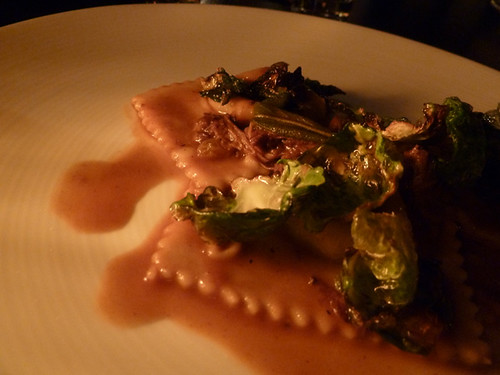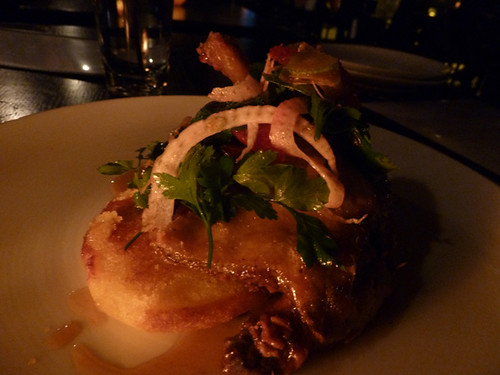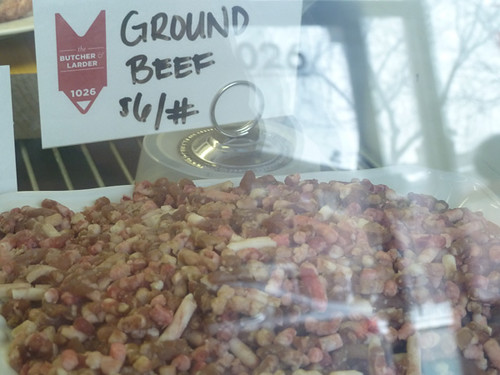
When Rob and Allie Levitt left Mado to start a butcher shop, I was concerned that we’d lost one of the best restaurants in town (and I mean that in a 2 or 3 at most sense, not an airily wide-ranging sense) and would gain a business that couldn’t make it on volume, was just too specialized. Which just shows that Rob sees more in a piece of meat than I do— literally; one of the first things you notice at The Butcher & Larder is just how many product offerings they can make out of the same carcass. But also, he saw more customers out there who would want that sort of thing and be willing to pay for it, and he was evidently right, to judge by his tweets around Valentine’s Day which were more about what he was out of than what he had.
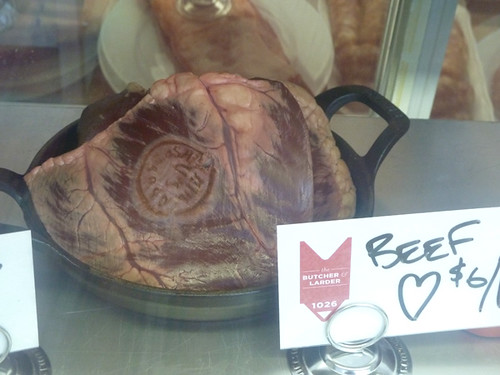
What’s fascinating to me is how readily a decent-sized customer base has taken to their non-supermarket way of selling stuff— we have what we carved out of the animals we have, and if we don’t have what you came in for, we’ll sell you what we do have and tell you how to make it. I’m sure Mado wasn’t the highest volume local-farmer, nose-to-tail restaurant in town, but no other place impressed upon me so strongly what eating by the seasons and making use of everything you get in really amounted to, and not just because I made a video about them. You saw it in their vegetables, too (alas, something you can’t get at The Butcher & Larder), the simplest treatment of what came from the market this week opening your eyes to the flavors of something like sunchokes or beets in a way that nothing ever had before. Meat palace Mado was also the best vegetable restaurant in town, in my book, because of the respect with which they treated the natural, evanescent goodness in everything.
I was thinking about this as I sat down to lunch at The Butcher & Larder:
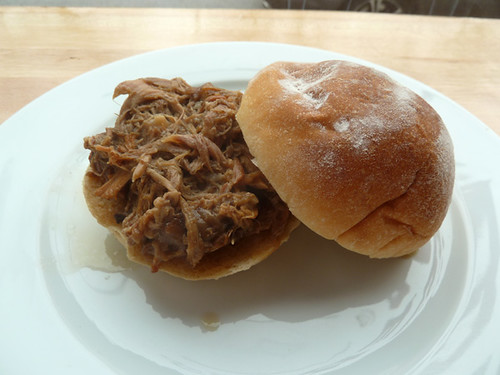
This was beer-braised pork shoulder. And what’s funny about it is how little Rob evidently cares about the trappings of contemporary dining versus simply doing the right thing by meat. If you got a sandwich like this at another locavorish kind of place— City Provisions, say— you’d get some arty little crispy chips with it, or you’d order a side of beet salad, or something. Or there would at least be some fancy toppings on it, a little shaved fennel pickled in red wine vinegar. They’d make a nice-looking combo out of it. At The Butcher & Larder, you get a generic bag of supermarket potato chips and a pop, just like you’d get at some sub place on the south side. I can’t help but think there will be Yelp reviews shortly getting indignant about this, wondering why there aren’t truffle chips like at Grahamwich. But then you bite into the sandwich… and the cares of the world, the jostling and striving, melt away. It’s just pure porkerifficness, bathed in beer and a few spices, but most of all, in the time to do it right.
As at Mado, Rob Levitt believes you either get it or you don’t, and if you don’t, there’s somewhere else out there for you, and someone else out there waiting to buy from him.
* * *
I have a The Butcher & Larder problem, though. Which is that for years I have casually referred to Paulina Market as the Greatest Butcher Shop in the Universe. And I’ve lived here for 20+ years without ever once having to contemplate a rival for the title.
Of course, the world is a big place with many different things, and there’s no reason that I have to choose between two such different businesses, just because they sell roughly the same thing. Paulina was an old-school German meat market, back when that’s what my neighborhood was, that successfully escaped being pigeonholed as an ethnic market and made the jump to simply being a superior meat market for those who were savvy enough to know that when you wanted a steak to cook out, you didn’t go to the Jewels, you went to Paulina.
And I’ve gone to Paulina for decades, and taken my kids who they’ve watched grow up (and who eagerly look forward to free samples of bologna— I avoided bologna for 20 years, but if you want to know how good the most routine of lunchmeats can be, go to Paulina and try what they make in house). Now, along the way I’ve obviously become conscious like many people of the issues involved in how meat is raised, and I’m a big partisan of non-industrial pork and a somewhat more qualified one of artisanal beef. So to some extent I’ve followed my values to buying more meat from the farmer’s markets and the like.
But those aren’t my only values; I also have ones about supporting ethnic diversity in Chicago, and patronizing businesses that come to know their customers, and spending my money at places that do things the right way because they’ve always done things the right way. And so every week I go to Paulina for some of the things that they make in an old-school, non-industrialized, real ingredients kind of way: their bologna, their baked ham, their summer sausage, their hot dogs. What Rob Levitt had to rediscover and reintroduce to his customers on one side of the great mass industrialization of American food, they’ve been keeping alive from the other side, from before it happened.
I sent a friend a couple of recipes for things I’ve been making from what they offer at Paulina for literally two decades now. They barely qualify as recipes, they’re so simple, and Paulina does the hard work in both cases. But they’re both great winter meals that you’ll be glad you added to your repertoire.

Simplified Choucroute Garni For a Busy Night
6 Paulina Thuringer sausages (they’re precooked, fyi)
1 container Paulina sauerkraut
2 lbs. small red potatoes
Cut potatoes in half, cut sausages in thirds. Dump kraut in big stockpot, mix potatoes and sausages into kraut, pour enough water to 2/3 cover it all. Sprinkle with pepper (no salt, there’s plenty in the kraut). Heat with lid on until potatoes are soft, stirring it around carefully to mix what’s on top down into the bottom from time to time. Serve with a dab of brown mustard on the side.
Split Pea Soup With Paulina Ham Hock
1 Paulina ham hock aka pork shank
1 or 1-1/2 packages of split peas, or navy beans, or canned chickpeas
1 medium onion
1 carrot
Dice carrot and onion, doesn’t have to be too fine. Cover hamhock and vegetables with water in a stockpot or dutch oven. Simmer for an hour or two. Add split peas or beans and cook till soft (obviously, if you use dried beans, use the appropriate process to soften them up first; split peas will soften in about an hour or so).
Take hamhock out and let cool while you puree soup. Cut band of skin off hock and start hunting for the pieces of meat hidden inside, cutting or scraping away big hunks of fat; dice meat and toss it back in the soup. Give them another 20 minutes to melt out some gelatin and blend flavors. Salt to taste.
The Butcher & Larder
1026 N Milwaukee
Chicago, IL 60642
(773) 687-8280
www.thebutcherandlarder.com
Paulina Market
3501 North Lincoln Avenue
Chicago, IL 60657
(773) 248-6272
www.paulinameatmarket.com


 Posted in
Posted in 




